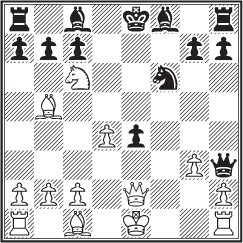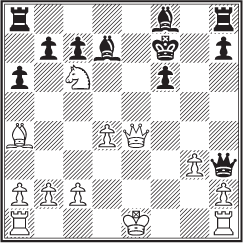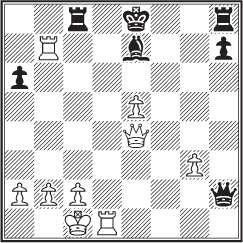
Fischer disclosed more of his broad, new repertoire in a five-minute tournament at Herceg-Novi, right after Belgrade on April 8. Dubbed by journalists the “world blitz championship,” the double-round event was a splendid success for Fischer, who seemed able to win easily regardless of opening move. He beat Petrosian with 1 e4, Tal with 1 g3, Smyslov with 1 f4, and Hort with 1 d4 (He had told friends he prepared 1 d4 specifically for Spassky when it appeared they would meet on first board in Belgrade.) At the risk of violating Nezhmetdinov’s Law (“He who analyzes blitz games is stupid”), here is his most sparkling game.
Fischer – Milan Matulović
Blitz tournament, Herceg-Novi 1970
Ruy Lopez, Schliemann Defense (C63)
1 |
e4 |
e5 |
2 |
♘f3 |
♘c6 |
3 |
♗b5 |
f5 |
Fischer wrote that he was surprised at Black’s choice of the Schliemann because “I know this variation very well.” In fact, he never played it in another serious game that we know of.
4 |
♘c3 |
fxe4 |
5 |
♘xe4 |
d5 |
6 |
♘xe5 |
dxe4 |
7 |
♘xc6 |
♕g5 |
♕e2 |
♘f6 |
|
9 |
f4 |
♕xf4! |
When this was played, the standard authorities believed 9...♕h4+ was forced (although better for White). The capture on f4 was supposed to be worse because of 10 ♘e5+ c6 11 d4 exd3 12 ♗xd3 ♕b4+ 13 ♗d2 ♕e7 14 0-0-0. But later 11...♕h4+ 12 g3 ♕h3 was found to be better than its reputation, raising doubts about 10 ♘e5+.
The theory of 1970 also regarded 10 ♘xa7+ ♔d8 11 ♘xc8 ♔xc8 12 d4 as quite good for White. But that underestimated 10...♗d7 11 ♗xd7+ ♔xd7 12 ♕b5+ ♔e6!.
10 |
d4 |
♕h4+?! |
11 |
g3 |
♕h3 |

Fischer felt he won this game two years before: One night at Vinkovci 1968 he analyzed the variation in depth with Robatsch and Gheorghiu (the latter had failed to gain an edge at Skopje 1968 with the theory-endorsed 12 ♘a7+ ♗d7 13 ♗xd7+ ♕xd7 14 ♘b5 and now 14...c6 15 ♘c3 ♗b4!). The three men stayed up all night and found:
12 |
♗g5! |
a6 |
13 |
♗a4 |
♗d7 |
Attempts to improve on Black’s play start here. They include:
(a) 13...b5 14 ♗xf6 bxa4 and now 15 ♕xe4+ ♕e6 16 ♕xe6+? ♗xe6 17 ♗e5 ♗d5 is lost. But 15 ♗e5 or 15 ♕xe4+ ♕e6 16 ♗e5 ♗b7 17 d5 favors White.
(b) 13...♕h5 14 ♕xh5+ ♘xh5 15 ♘e5+ c6 16 ♗b3 ♘f6 17 ♘f7! costs material.
(c) 13...♗d6 14 ♗xf6 favors White.
14 |
♗xf6 |
gxf6 |
15 |
♕xe4+ |
|
White is clearly better after 15...♕e6 16 ♕xe6+ ♗xe6 17 0-0 (17...♗d7 18 ♖ae1+ ♔f7 19 ♘e5+).
15 |
... |
♔f7 |

16 |
♘e5+! |
fxe5 |
17 |
♖f1+ |
|
Now 17...♔g8 18 ♖f6!! is strong. For example, 18...♗xa4 19 ♕d5+ and mates. Or 18...♖e8 19 ♗b3+ ♔g7 (19...♗e6 20 ♗xe6+ ♖xe6 21 ♕d5) 20 ♖f7+ ♔h6 21 dxe5.
The best practical chances lie in 18...♗b4+ 19 c3 ♖f8! and then 20 ♕d5+ ♔g7 21 ♗xd7 ♕xh2 22 ♖xf8 ♖xf8 23 0-0-0.
17 |
... |
♔e7! |
Black has enough pieces for the queen after 17...♕xf1+ 18 ♔xf1 ♗xa4 but not enough pawns (19 ♕f5+ ♔g8 20 ♕e6+ ♔g7 21 ♕xe5+ and 22 ♕xc7).
18 |
♗xd7! |
|
Black is the one playing to win after 18 ♕xe5+ ♕e6 19 ♖f7+! ♔xf7 20 ♗b3 ♖e8!.
18 |
... |
♔xd7! |
On 18...♕xd7 19 0-0-0 ♕e6 20 ♕xb7 White has good chances.
19 |
♖f7+? |
|
Not 19 ♕xb7 ♕e6! 20 0-0-0 (20 ♕xa8? ♗b4+) e4!. But 19 0-0-0 keeps the balance.
19 |
... |
♔e8? |
On 19...♗e7!! 20 ♕xe5 ♖ae8 or 20 0-0-0 ♕e6 Black is the one playing for a win.
20 |
♖xc7 |
♗d6? |
In a speed game, Fischer would probably have answered 20...♗b4+ 21 c3 ♖f8 with 22 0-0-0!, rather than 22 cxb4 – and his instinct would be borne out by 22 cxb4? ♕f1+ 23 ♔d2 ♖f2+ 24 ♔c3 ♖f3+ with a winning counterattack after 25 ♔d2 ♕f2+.
But 20...♕e6 21 0-0-0 ♗e7 would have limited White’s superiority.
21 |
♖xb7! |
|
After 21 ♕xb7 ♗xc7 22 ♕xa8+ ♗d8 Black is still hanging on.
21 |
... |
♖c8 |
Black cannot allow 22 ♕c6+, and 21...♕e6 22 ♖xh7 ♖xh7 23 ♕xa8+ should lose.
22 |
0-0-0 |
♕xh2? |
23 |
dxe5 |
♗e7 |

24 |
♖xe7+! |
|
Widely praised at the time because it forces mate. But 24 ♕a4+! ♔f7 25 ♖f1+ ♔g6 26 ♖b6+ also mates.
24 |
... |
♔xe7 |
25 |
♕b7+ |
♔e6 |
26 |
♕d7+ |
♔xe5 |
27 |
♕d5+ |
|
Here 27 ♖d5+ saves a few moves.
27 |
... |
♔f6 |
28 |
♖f1+ |
♔g6 |
29 |
♕f5+ |
|
Also 29 ♕f7+!.
The game ended with: 29 ... ♔h6 30 ♕e6+ ♔h5 31 ♖f5+ ♔g4 32 ♖f4+ ♔xg3 33 ♕g4 mate